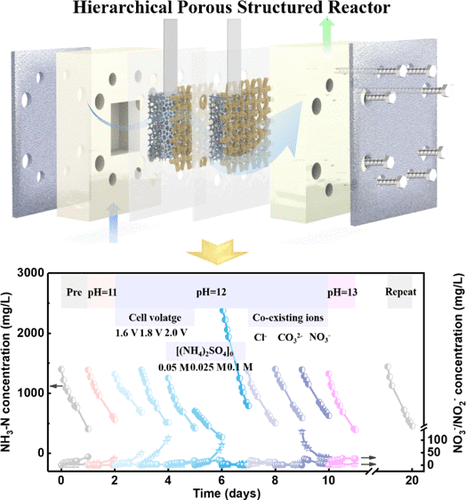当前位置:
X-MOL 学术
›
Environ. Sci. Technol.
›
论文详情
Our official English website, www.x-mol.net, welcomes your
feedback! (Note: you will need to create a separate account there.)
Optimization of a Hierarchical Porous-Structured Reactor to Mitigate Mass Transport Limitations for Efficient Electrocatalytic Ammonia Oxidation through a Three-Electron-Transfer Pathway
Environmental Science & Technology ( IF 10.8 ) Pub Date : 2021-09-08 , DOI: 10.1021/acs.est.1c02825 Zichen Liu 1, 2 , Gong Zhang 3 , Huachun Lan 3 , Huijuan Liu 3 , Jiuhui Qu 3, 4
Environmental Science & Technology ( IF 10.8 ) Pub Date : 2021-09-08 , DOI: 10.1021/acs.est.1c02825 Zichen Liu 1, 2 , Gong Zhang 3 , Huachun Lan 3 , Huijuan Liu 3 , Jiuhui Qu 3, 4
Affiliation

|
Regulation of fast three-electron-transfer processes for electrocatalytic oxidation of ammonia to nitrogen by achieving efficient generation and utilization of active sites is the optimal strategy in ammonia-containing wastewater treatment. However, the limited number of accessible active sites and sluggish interfacial mass transfer are two main bottlenecks restricting conventional ammonia oxidation configurations. Herein, we develop a macroporous Ni foam electrode integrated with vertically aligned two-dimensional mesoporous Ni2P nanosheets to create sufficient exposure of active centers. A novel ammonia oxidation reactor with the developed hierarchical porous-structured electrodes was assembled to construct an intensified microfluidic process with flow-through operation to mitigate macroscopic mass transport limitations. The confined microreaction space in the hierarchical porous reactor further promotes spontaneous nanoscale diffusion/convection of the target contaminant to high-valence Ni sites and enhances the microscopic mass transfer. The combined results of electrochemical measurements and in situ Raman spectra showed that the ammonia degradation mechanism results from direct oxidation by the high-valence Ni, significantly different from the conventional indirect active-chlorine-species-mediated oxidation. The optimized reactor achieves high-efficiency three-electron-transfer ammonia conversion with an ammonia removal efficiency of ∼70% from an initial concentration of ∼1400 mg/L and byproduct production of ∼4%, significantly superior to a conversion unit comprising a featureless Ni-based electrode in the immersed configuration, which had >50% byproduct yield. 20 days of continuous operation under variable conditions achieved >90% ammonia degradation performance and an energy consumption of 25.42 kW h kg–1 N (1 order of magnitude lower than the active-chlorine-mediated process), showing the potential of the reactor in medium-concentration ammonia-containing wastewater treatment.
中文翻译:

优化分级多孔结构反应器以减轻通过三电子转移途径进行高效电催化氨氧化的传质限制
通过实现活性位点的有效生成和利用来调节氨电催化氧化成氮的快速三电子转移过程是含氨废水处理的最佳策略。然而,有限数量的可及活性位点和缓慢的界面传质是限制常规氨氧化配置的两个主要瓶颈。在此,我们开发了一种与垂直排列的二维介孔 Ni 2集成的大孔泡沫镍电极P 纳米片以产生足够的活性中心暴露。组装了具有开发的分级多孔结构电极的新型氨氧化反应器,以构建具有流通操作的强化微流体过程,以减轻宏观传质限制。分级多孔反应器中受限的微反应空间进一步促进了目标污染物向高价镍位点的自发纳米级扩散/对流,并增强了微观传质。电化学测量和原位测量的综合结果拉曼光谱表明氨降解机制是由高价镍直接氧化引起的,与传统的间接活性氯物种介导的氧化显着不同。优化后的反应器实现了高效的三电子转移氨转化,初始浓度约 1400 mg/L 的氨去除效率约 70%,副产物产量约 4%,明显优于包含无特征的转化装置。浸入式镍基电极,副产品产率 > 50%。在可变条件下连续运行 20 天,氨降解性能达到 >90%,能耗为 25.42 kW h kg –1 N(比活性氯介导的工艺低 1 个数量级),显示了该反应器在中浓度含氨废水处理中的潜力。
更新日期:2021-09-21
中文翻译:

优化分级多孔结构反应器以减轻通过三电子转移途径进行高效电催化氨氧化的传质限制
通过实现活性位点的有效生成和利用来调节氨电催化氧化成氮的快速三电子转移过程是含氨废水处理的最佳策略。然而,有限数量的可及活性位点和缓慢的界面传质是限制常规氨氧化配置的两个主要瓶颈。在此,我们开发了一种与垂直排列的二维介孔 Ni 2集成的大孔泡沫镍电极P 纳米片以产生足够的活性中心暴露。组装了具有开发的分级多孔结构电极的新型氨氧化反应器,以构建具有流通操作的强化微流体过程,以减轻宏观传质限制。分级多孔反应器中受限的微反应空间进一步促进了目标污染物向高价镍位点的自发纳米级扩散/对流,并增强了微观传质。电化学测量和原位测量的综合结果拉曼光谱表明氨降解机制是由高价镍直接氧化引起的,与传统的间接活性氯物种介导的氧化显着不同。优化后的反应器实现了高效的三电子转移氨转化,初始浓度约 1400 mg/L 的氨去除效率约 70%,副产物产量约 4%,明显优于包含无特征的转化装置。浸入式镍基电极,副产品产率 > 50%。在可变条件下连续运行 20 天,氨降解性能达到 >90%,能耗为 25.42 kW h kg –1 N(比活性氯介导的工艺低 1 个数量级),显示了该反应器在中浓度含氨废水处理中的潜力。











































 京公网安备 11010802027423号
京公网安备 11010802027423号